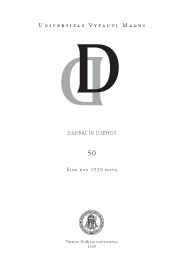TRUMPINIMAS IR DAŽNUMO POVEIKIS ŠNEKAMOJOJE KALBOJE
SHORTENING AND THE FREQUENCY EFFECT IN SPOKEN LANGUAGE
Author(s): Ineta DabašinskienėSubject(s): Language and Literature Studies
Published by: Vytauto Didžiojo Universitetas
Keywords: šnekamosios kalbos tyrimai; spontaniška kalba; tekstynas; morfologinės formos; spoken language research; spontaneous speech; morphological forms
Summary/Abstract: Spoken language research is not a very popular field of studies in Lithuania. In order to analyze spontaneous speech the corpus has to be developed and that requires enormous human, technical, and financial resources. The process is very long and time-consuming, and it demands special preparation and accuracy. This study is based on the analysis of spoken Lithuanian. The data of adult-directed speech (ADS) are analyzed to reveal the frequency distribution of the parts of speech, as well as their forms. The main aim of this paper is to analyze the frequency effect on word form and meaning. The processes of reduction and shortening are observed in nouns and verbs, especially in the categories of case, number, person, and tense. The main feature of spontaneous speech related to linguistic economy helps to explain the phenomenon of frequency effect; it shows the tendencies in reduction and shortening. The work of cognitive systems, psycholinguistic approach, and main principle of natural theory can be used to explain the above-mentioned processes: ‘more or less natural’ corresponds to ‘more or less easy for the human brain’ (Dressler et al. 1987); thus, shortening is observed more frequently in less natural forms (usually, in longer forms). With respect to language acquisition, this principle means that easier morphological forms are mastered faster because they are more natural. Morphologically natural forms are characterized as being rule-derived, transparent (i.e., their meaning is more easily segmentable), unmarked, and showing frequent usage.
Journal: Darbai ir dienos
- Issue Year: 2009
- Issue No: 50
- Page Range: 109-117
- Page Count: 9
- Language: Lithuanian

